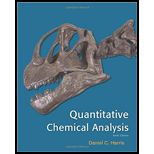
a)
Interpretation:
The equations have to be written for
Concept Introduction:
Beer law:
To write the equations for
To prove
a)
Explanation of Solution
The solution obtained by solving the two above equations are,
Divide the expression for
Divide the numerator and denominator on right side by
b)
Interpretation:
The equations
To prove
b)
Explanation of Solution
For indicator, the mass balance can be given as ,
Divide by
The acid dissociation constant of the indicator is,
Substitute
c)
Interpretation:
To prove
c)
Explanation of Solution
Hence,
Therefore,
d)
Interpretation:
With the help of Carbonic acid dissociation equilibria
To prove
d)
Explanation of Solution
From the acid dissociation reaction of Carbonic acid, it can be written as,
From the acid dissociation reaction of Bicarbonate, it can be written as,
Substitute in
e)
Interpretation:
The charge balance for the solution has to be determined and substituted in expressions for
To determine the charge balance for the solution and substitute the expressions for
e)
Explanation of Solution
The charge balance is given as,
f)
Interpretation:
The amount of
To find the amount
f)
Explanation of Solution
The value of
g)
Interpretation:
The ionic strength inside the sensor compartment has to be determined.
To determine the ionic strength inside the sensor compartment
g)
Explanation of Solution
The exact ionic strength can be calculated as,
Ionic strength =
Want to see more full solutions like this?
Chapter 19 Solutions
Quantitative Chemical Analysis 9e & Sapling E-Book and Homework for Quantitative Chemical Analysis (Six Month Access) 9e
 ChemistryChemistryISBN:9781305957404Author:Steven S. Zumdahl, Susan A. Zumdahl, Donald J. DeCostePublisher:Cengage Learning
ChemistryChemistryISBN:9781305957404Author:Steven S. Zumdahl, Susan A. Zumdahl, Donald J. DeCostePublisher:Cengage Learning ChemistryChemistryISBN:9781259911156Author:Raymond Chang Dr., Jason Overby ProfessorPublisher:McGraw-Hill Education
ChemistryChemistryISBN:9781259911156Author:Raymond Chang Dr., Jason Overby ProfessorPublisher:McGraw-Hill Education Principles of Instrumental AnalysisChemistryISBN:9781305577213Author:Douglas A. Skoog, F. James Holler, Stanley R. CrouchPublisher:Cengage Learning
Principles of Instrumental AnalysisChemistryISBN:9781305577213Author:Douglas A. Skoog, F. James Holler, Stanley R. CrouchPublisher:Cengage Learning Organic ChemistryChemistryISBN:9780078021558Author:Janice Gorzynski Smith Dr.Publisher:McGraw-Hill Education
Organic ChemistryChemistryISBN:9780078021558Author:Janice Gorzynski Smith Dr.Publisher:McGraw-Hill Education Chemistry: Principles and ReactionsChemistryISBN:9781305079373Author:William L. Masterton, Cecile N. HurleyPublisher:Cengage Learning
Chemistry: Principles and ReactionsChemistryISBN:9781305079373Author:William L. Masterton, Cecile N. HurleyPublisher:Cengage Learning Elementary Principles of Chemical Processes, Bind...ChemistryISBN:9781118431221Author:Richard M. Felder, Ronald W. Rousseau, Lisa G. BullardPublisher:WILEY
Elementary Principles of Chemical Processes, Bind...ChemistryISBN:9781118431221Author:Richard M. Felder, Ronald W. Rousseau, Lisa G. BullardPublisher:WILEY





